HMS Hardy (1912)
 | |
| History | |
|---|---|
| Class and type: | Acasta-class destroyer |
| Name: | HMS Hardy |
| Builder: | John I. Thornycroft & Company |
| Laid down: | 13 November 1911 |
| Launched: | 10 October 1912 |
| Fate: | Sold for breaking to Thos W Ward of Briton Ferry |
| General characteristics | |
| Displacement: |
|
| Length: | 267 ft 6 in (81.53 m) |
| Beam: | 27 ft (8.2 m) |
| Draught: | 10 ft 6 in (3.20 m) |
| Installed power: | 24,500 ihp (18,300 kW) |
| Propulsion: |
|
| Speed: | 29 kn (54 km/h) |
| Complement: | 72 |
| Armament: |
|
HMS Hardy was a Royal Navy ship that was one of 20 Acasta-class destroyers. Serving during World War I, she was part of the Grand Fleet at the Battle of Jutland. Hardy was built by John I. Thornycroft & Company and laid down on 13 November 1911. The ship was launched on 10 October 1912 and completed on 1 September 1913.[1] She was the 6th vessel of the Royal Navy to bear the name Hardy and the 3rd to receive battle honours.[2]
Specifications
The standard build of Acasta-class destroyers' had a displacement of 892 tons when containing standard load and 1072 tons when containing deep load. The ships' dimensions were 267 ft 6in × 27 ft × 10 ft 5in. At a speed of 15kn the class' stated range was 1,540nm, while the top speed was 29kn. Acasta-class destroyers were armed with three 4 inch guns and two torpedo tubes. Vessels were powered by 2-shaft, oil fired turbines and had a fuel capacity of 199 tons of oil.[3]
Hardy's pennant numbers were H67, H39, and H88.[1]
World War I
During the war Hardy was part of the 4th Destroyer Flottila, a component of the British Grand Fleet.[4]
On 16 December 1914, HMS Hardy saw action in the Dogger Bank area in the early stages of the German raid on Scarborough, Hartlepool and Whitby. It incurred significant damage and had to limp back to port under escort from HMS Spitfire. Three crew were killed and ten wounded.[5]
On 31 May — 1 June 1916, Hardy saw action in the Battle of Jutland.[4]
In August 1916 the Fourth Destroyer Flotilla, to which Hardy belonged, was removed from fleet work and spent most of the rest of the war in Devonport, where its rosters of destroyer grew in numbers until it reached 50 ships in July, 1918[6]
Commanding officers
- Lieutenant-Commander Lewis G.E. Crabbe was appointed on 27 August 1913.[7]
- Commander Richard A. A. Plowden was the commanding officer at the battle of Jutland.[4]
- Lieutenant Edward Eastwick-Field was appointed on 28 December 1918[8]
Fate
HMS Hardy was sold for breaking on 9 May 1921 to Thos W Ward's at Briton Ferry. [9][10]
References
- ↑ "Acasta (K) Class (1912) DD Spec". Britainsnavy.co.uk. 2012-05-24. Retrieved 2014-02-25.
- 1 2 3 The Admiralty (1920). Battle of Jutland, 30th May to 1st June 1916: Official Despatches with Appendices. London: H.M. Stationery Office.
- ↑ "Hartlepool, Scarborough, Whitby Raid, December 1914, and minesweeping, Killed and died, Medals". Naval-history.net. Retrieved 2014-02-25.
- ↑ "Fourth Destroyer Flotilla (Royal Navy)". The Dreadnought Project. Retrieved 2014-02-25.
- ↑ The Navy List, Apr. 1914 p.322b (p. 413 in online reader)
- ↑ The Navy List, Oct. 1919 p.809 (p. 662 in online reader)
- ↑ "Thornycroft - World Naval Ships Directory". Worldnavalships.com. Retrieved 2014-02-25.
- ↑ "HMS Hardy (1913) DD 6". Britainsnavy.co.uk. Retrieved 2014-02-25.